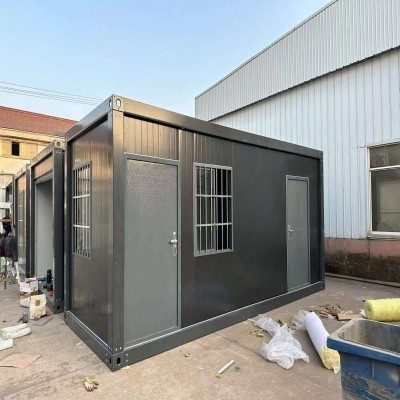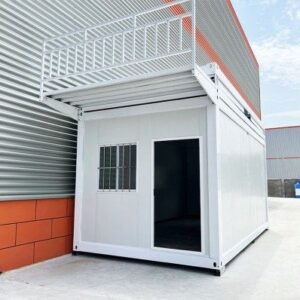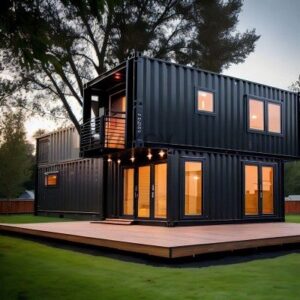Breaking Down the Costs of a Container Van House in the Philippines 2025
When thinking about how much container van house in philippines, it’s crucial to consider all the factors that make up the price. Whether you’re eyeing a 20ft or 40ft container house, upfront costs, modifications, and local market trends all play a role.
Upfront Pricing Table for Container Houses 2025
| Container Size | Base Price Range (PHP) | Estimated Total Cost (PHP) | Notes |
|---|---|---|---|
| 20ft Container | ₱150,000 – ₱250,000 | ₱350,000 – ₱600,000 | Basic model, minimal renovations |
| 40ft Container | ₱250,000 – ₱400,000 | ₱600,000 – ₱1,000,000 | More space, more customization |
Prices vary depending on new or used containers.
Cost Factors Deep Dive
- Container Purchase – New containers cost more but last longer. Used containers are cheaper but may need more repairs.
- Design and Renovation – Adding windows, doors, insulation, and electrical/piping works can significantly increase costs.
- Foundation and Setup – Ground preparation, foundations, and securing permits add expenses.
- Insulation and Typhoon-proofing – Given the Philippines’ climate, investing in proper insulation and reinforcement is essential.
- Labor Costs – Skilled labor varies by region, impacting the overall budget.
- Additional Features – Adding solar panels, rainwater systems, or eco-friendly materials can affect prices.
Inflation and Market Update 2025
Due to rising material and fuel costs, prices have increased by roughly 5 to 8% compared to 2025. Import restrictions for steel and container availability also influence costs, especially in urban areas like Metro Manila and Cebu.
Case Study
A typical 40ft modular container house design in Metro Manila costs around ₱900,000. This includes:
- Purchase of a new container van: ₱350,000
- Structural and finishing work: ₱400,000
- Electrical and plumbing: ₱100,000
- Permits and installation: ₱50,000
This project took approximately 2 months to complete, balancing affordability with typhoon resistance and energy efficiency.
Understanding these cost components helps you prepare for the real expenses when building a container van house in the Philippines.
Pros and Cons of Container Van Houses for Your Filipino Lifestyle
Pros of Container Van Houses in the Philippines
Container van houses are becoming popular in the Philippines for a reason. Here are some key advantages:
- Affordable and Faster ConstructionCompared to traditional homes, container houses save time and money. You can find affordable prefab container houses in Manila and other urban areas, which means less waiting and lower labor costs.
- Durability and Typhoon ResistanceMade from steel, container homes are naturally strong and can withstand harsh weather conditions, including typhoon-resistant container homes popular in coastal regions like Davao.
- Flexible and Modular DesignsThese homes are easy to expand or modify. Whether you want a small office, guesthouse, or permanent home, modular container house designs in 2025 let you customize based on your needs.
- Eco-Friendly and Sustainable Housing OptionRepurposing shipping containers promotes sustainability. This appeals especially to those seeking eco-friendly tiny homes in the Philippines with a smaller carbon footprint.
- PortabilityYou can move your container home if needed, useful for remote workers or families relocating frequently.
Cons of Container Van Houses in the Philippine Context
While there are benefits, some challenges might affect your decision:
- Limited Size and Layout ConstraintsStandard containers come in 20ft or 40ft lengths, which can restrict space and design flexibility compared to conventional homes.
- Insulation and Comfort IssuesWithout proper insulation, container houses can become too hot or cold. Given the Philippine climate, this means extra investment in cooling or insulation systems.
- Legal and Zoning HurdlesNot all local governments have clear rules on container houses. You might face delays or additional requirements to prove your home is legal in the Philippines.
- Maintenance and Corrosion RisksThe humid, salty air in many parts of the country can cause rust if the container isn’t properly treated or maintained.
- Resale Value UncertaintyContainer homes are still relatively new in the Philippine property market, so their resale value might be less predictable compared to traditional houses.
Local Nuances to Consider
- Location MattersUrban areas like Metro Manila or Cebu offer more amenities but might have stricter building codes for container van houses. Rural areas might be flexible but lack infrastructure.
- Community AcceptanceNeighbors may be unfamiliar with the concept, which can affect community relations if the aesthetic is unconventional.
- Financing OptionsWhile Pag-IBIG financing for prefab houses is growing, not all lenders readily support container home loans yet.
Decision Framework for Filipino Buyers
Ask yourself:
- What is your budget and timeframe? Container houses can be cheaper and faster but watch for hidden costs like insulation and installation fees.
- Are you prepared for maintenance? Steel homes need rust protection and upkeep in the Philippine climate.
- Do you value flexibility and sustainability? If yes, container homes might be a perfect fit.
- Can you navigate the legal landscape? Consult local authorities early to avoid surprises.
This balanced view helps you weigh whether a container van house aligns with your lifestyle, budget, and future plans in the Philippines.
Legal and Practical Considerations for Container Van Houses in the Philippines
When planning to build a container van house in the Philippines, understanding the legal landscape and practical requirements is crucial. This ensures your project complies with local rules and is safe, durable, and sustainable.
Regulations on Container Houses in the Philippines
Container houses are generally legal as long as they meet local building codes and zoning laws. However, these codes vary by region:
- Barangay and City Permits: You need a building permit from your local barangay or city hall. Check if your lot is zoned for residential use and container homes.
- Structural Compliance: Philippine building codes require structures, including container homes, to meet standards for load-bearing, stability, and safety, especially given the country’s typhoon-prone environment.
- Environmental Clearances: Depending on your location, you may need environmental permits, especially if building near protected areas.
Legal hoops can seem tricky, but consulting with local architects or builders experienced in container van houses can smooth the process.
Installation Tips for Container Van Houses
Proper installation is key for container homes, especially in the Philippines, where climate and terrain affect durability.
- Site Preparation: Level the ground and lay a sturdy foundation — common options are concrete piers or slabs to prevent moisture and pests.
- Professional Modification: Cutting windows, doors, and insulation installation should be handled by pros to maintain the container’s structural integrity.
- Climate Proofing: Apply insulation and weatherproof coatings suitable for tropical, humid weather to avoid corrosion and maintain inside comfort.
For detailed modular container house designs and installation options in the Philippines, check resources like YC Container House.
Maintenance Guide for Container Van Houses
Regular upkeep extends the life of your container home and preserves its value.
- Rust Prevention: Frequent inspections and repainting with rust-resistant coatings help combat the humid Philippine climate.
- Pest Control: Ensure seals are tight to keep out insects and rodents.
- Waterproofing: Regularly check for leaks or water accumulation around the foundation, especially during rainy seasons.
- HVAC Maintenance: Use energy-efficient air conditioning or ventilation adapted for tight container spaces.
Sustainability and Eco-Friendly Considerations
Container van houses offer an eco-friendly alternative but require mindful choices to maximize their green potential.
- Recycled Materials: Using repurposed containers reduces waste and demand for new construction materials.
- Energy Efficiency: Installing solar panels and efficient insulation cuts electricity costs and carbon footprint.
- Water Management: Implement rainwater harvesting systems tailored for Philippine rainfall to support off-grid living.
- Local Sourcing: Using locally sourced materials and labor supports sustainability and reduces transport emissions.
By combining these legal and practical tips, you can build a typhoon-resistant container home that fits well with Philippine environmental and community standards.
For more on container house costs and building steps specific to local conditions, visit How much to build a shipping container house.
What Is a Container Van House and Why It’s Gaining Popularity in the Philippines
Understanding Container Van Houses
A container van house is a type of modular home made by converting shipping containers into livable spaces. These structures are sturdy, portable, and designed to maximize limited space efficiently. Typically, containers come in standard sizes like 20ft and 40ft, allowing for flexible design options including single units or stacked configurations. What makes container houses unique is their affordability, durability, and quick construction time compared to traditional homes.
Rising Popularity in the Philippine Context
In the Philippines, container van houses are catching on for several reasons. The country’s densely populated urban centers like Metro Manila, Cebu, and Davao face rapid housing shortages. At the same time, Filipino families and young professionals seek affordable, eco-friendly, and space-saving alternatives amid rising real estate prices. Shipping containers, often readily available at ports, are a cost-effective base material. Their metal structure resists pests like termites, a common issue in tropical climates, and with proper insulation, they cope well with heat and humidity.
Moreover, container homes are appealing as typhoon-resistant housing options, an important consideration given the Philippines’ exposure to extreme weather. Prefab container house designs allow quick installation and relocation, which fits the dynamic lifestyle and constraints of many Filipinos.
Yichen Insight on Local Trends
From our perspective at yichen, the container van house trend reflects a shift towards smarter, sustainable living in the Philippines. We see a growing market for not only new container homes but also used container vans for sale in places like Cebu, making entry points accessible for a wider range of budgets.
The flexibility of container conversions aligns well with Filipino values of adaptability and resourcefulness. Whether for a small family, an officetel, or a guesthouse, these homes offer practical solutions without sacrificing comfort.
Visualizing the Container Home
Imagine a compact yet cozy space with natural light streaming through cleverly placed windows, built-ins that optimize every inch, and vibrant local materials blending with the industrial feel of steel walls. These homes reshape how Filipinos think about housing—from long, uncertain waits for traditional builds to quick, affordable, and quality living spaces ready to weather the country’s environmental realities.
In short, container van houses are more than just structures—they are a promising answer to the Philippines’ housing challenges, combining affordability, resilience, and innovation.
Top Tips to Save Money on Container Van House Cost Philippines and Maximize Value
Building or buying a container van house in the Philippines doesn’t have to drain your budget. With smart planning and applying a few key strategies, you can significantly cut costs while improving your home’s value and durability. Here’s how to make the most of your investment based on yichen recommendations and practical experience.
Budget Hacks for Affordable Container Van Houses
- Choose Used Container Vans WiselyBuying a second-hand container can save you 30-50% compared to brand new 40ft containers. Look for reputable sellers in Cebu or Metro Manila with well-maintained units to avoid high repair costs later.
- Opt for Modular Prefab DesignsPrefabricated container house modules reduce onsite labor and construction time. This approach minimizes installation fees and speeds up permitting since many modules come pre-approved.
- DIY Some Finishing WorkIf you have basic skills, doing interior finishes like painting, tiling, or simple carpentry yourself can cut labor costs by up to 40%. Just be mindful of local building regulations.
- Source Local MaterialsUse locally available materials for insulation, cladding, and interior updates. This lowers transport fees and supports Philippine suppliers. Materials like bamboo panels or recycled wood are eco-friendly and budget-friendly.
- Plan for Compact LayoutsSmaller footprint designs reduce container modifications and utility installs. A simple 20ft container home costs significantly less than customizing a 40ft unit with breakwalls or extra plumbing.

yichen Recommendations for Long-Term Savings
- Invest in Typhoon-Resistant UpgradesSpending a bit more on windproof coatings and reinforced frames pays off, given the Philippines’ typhoon-prone climate. This lowers future repair costs and protects your home.
- Consider Pag-IBIG Financing for Prefab HousesCheck if you qualify for Pag-IBIG loans on prefab container houses. Financing reduces upfront expenses and lets you stagger payments while enjoying your home.
- Regular Maintenance Saves DollarsKeep your container painted and sealed, check for rust and leaks yearly. This ensures your container home lasts beyond the average 25-30 year lifespan, safeguarding your investment.
ROI Projection of Container Van Homes in the Philippines
- Initial container house cost can be 30-60% less expensive than traditional houses of the same size.
- Energy savings from insulated containers and eco-friendly designs reduce utility bills by an estimated 15-25% annually.
- Typhoon-proof features decrease insurance premiums and repair expenses.
- Modular construction allows relatively easy upgrades or expansions, increasing resale value as demand for affordable prefab homes rises in Metro Manila, Cebu, and Davao.
By applying these budget tips and yichen insights, your container van house project will not only be wallet-friendly but also a smart, sustainable investment in 2025 and beyond.
and Next Steps with yichen on Container Van House Cost in the Philippines
After looking at the container van house cost in the Philippines and all the practical aspects, it’s clear that these homes offer an affordable and flexible alternative to traditional housing. Whether you’re considering a 20ft or 40ft container house, understanding the breakdown of expenses—from container purchase to installation fees—is key to making an informed decision.
If you’re serious about moving forward, here’s what to keep in mind with yichen:
- Evaluate your budget realistically: Factor in not just the container price but also renovation, utilities, permits, and maintenance.
- Research local suppliers and prefab modular designs that fit your needs, such as eco-friendly tiny homes or typhoon-resistant container homes especially important in the Philippines.
- Check legal and zoning requirements to ensure your container home project complies with local regulations.
- Consider financing options like Pag-IBIG financing for prefab houses to help ease upfront costs.
- Plan for long-term sustainability and durability, knowing that container homes can last decades with proper care.
- Use yichen’s insights and budget hacks to maximize your return on investment without compromising quality or safety.
Starting with yichen’s tailored advice can help you navigate the challenges of building a container van house in Metro Manila, Cebu, or Davao smoothly. With the right planning, this alternative housing choice can fit many Filipino lifestyles—offering affordability, mobility, and resilience.



